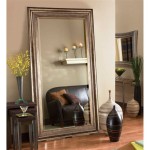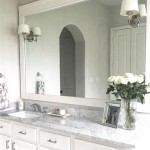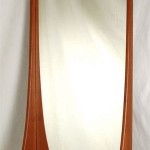How To Paint a Gold Mirror Frame: A Comprehensive Guide
A gold mirror frame can add a touch of elegance and sophistication to any room. Whether the current finish is outdated, damaged, or simply not fitting the desired aesthetic, painting the frame gold can revitalize its appearance. This article provides a comprehensive guide on how to paint a mirror frame gold, covering everything from preparation to the final coat. The process requires careful attention to detail and the use of the correct materials to achieve a professional-looking result.
The success of a gold paint job hinges on proper preparation. Skipping steps or using inappropriate materials can lead to a subpar finish, including peeling paint, uneven color, and visible imperfections. Thorough preparation ensures that the paint adheres correctly and provides a smooth, durable surface.
Key Point 1: Preparation - Laying the Foundation for a Flawless Finish
The preparation stage is arguably the most crucial part of the painting process. It involves cleaning, sanding, and priming the mirror frame to create a suitable surface for the gold paint. Neglecting any of these steps can significantly impact the final result.
Cleaning the Frame: Begin by thoroughly cleaning the mirror frame. Dust, dirt, grease, and other contaminants can prevent the paint from adhering properly. Use a soft cloth dampened with a mild detergent solution. Avoid using harsh chemicals or abrasive cleaners, as these can damage the frame's existing finish. For stubborn stains or grime, consider using a specialized cleaning product designed for the frame's material, whether it's wood, metal, or plastic. Ensure the frame is completely dry before proceeding to the next step.
Masking the Mirror: Protecting the mirror surface is essential. Use painter's tape to carefully mask off the edges of the mirror where it meets the frame. Apply the tape meticulously, ensuring a clean, straight line. Overlap the tape slightly onto the frame to prevent any paint from seeping onto the mirror. For added protection, consider covering the entire mirror surface with paper or plastic sheeting, securing it with painter's tape.
Sanding the Frame: Sanding is necessary to create a slightly roughened surface, allowing the primer and paint to grip the frame effectively. Use a fine-grit sandpaper (220-grit or higher) for this purpose. Gently sand the entire surface of the frame, paying particular attention to any areas with existing paint chips or imperfections. The goal is not to remove the existing finish entirely, but rather to create a "tooth" for the new paint to adhere to. After sanding, wipe the frame clean with a tack cloth to remove any sanding dust.
Priming the Frame: Priming is a critical step that enhances paint adhesion, seals the surface, and provides a uniform base for the gold paint. Choose a primer that is compatible with the frame's material and the type of paint being used. Apply a thin, even coat of primer using a brush or spray can. Allow the primer to dry completely according to the manufacturer's instructions. If necessary, lightly sand the primed surface with fine-grit sandpaper to smooth out any imperfections before applying the paint.
Key Point 2: Selecting the Right Materials - Ensuring Quality and Durability
Choosing the right materials is paramount to achieving a professional-looking and long-lasting gold finish. From the type of paint to the application tools, selecting high-quality materials is a worthwhile investment.
Choosing the Right Gold Paint: There are several types of gold paint available, each with its own characteristics and suitability for different projects. Common options include:
- Spray Paint: Spray paint is a convenient option for achieving a smooth, even finish, especially on intricate frames. Look for spray paints specifically formulated for metal or wood, depending on the frame's material. Opt for a high-quality spray paint that offers good coverage and durability.
- Acrylic Paint: Acrylic paint is a versatile option that can be applied with a brush or sponge. It is water-based, making it easy to clean up. Choose an acrylic paint with a metallic gold finish for the desired effect.
- Oil-Based Paint: Oil-based paint offers excellent durability and a rich, lustrous finish. However, it requires mineral spirits for cleanup and may have a stronger odor than water-based options.
- Gold Leafing: While not technically paint, gold leafing provides the most authentic gold finish. This involves adhering thin sheets of gold leaf to the frame's surface using a specialized adhesive. This technique requires more skill and patience than painting.
Choosing the Right Application Tools: The application tools will significantly impact the final finish.
- Brushes: If using acrylic or oil-based paint, choose high-quality brushes with synthetic bristles. Natural bristle brushes are generally better suited for oil-based paints. Select a brush size appropriate for the frame's details. Smaller brushes are ideal for intricate areas, while larger brushes are suitable for broader surfaces.
- Spray Paint Nozzles: When using spray paint, ensure the nozzle is clean and provides a consistent spray pattern. Test the spray pattern on a piece of cardboard before applying the paint to the frame.
- Paint Rollers: Small foam rollers can be used for applying paint to flat surfaces, but they are generally not suitable for intricate frames with detailed carvings.
- Masking Tape: High-quality painter's tape is essential for protecting the mirror surface. Choose a tape that is specifically designed for delicate surfaces to avoid damaging the mirror.
Safety Gear: Painting should always be done in a well-ventilated area. Wear a respirator or dust mask to protect against inhaling paint fumes or dust particles. Gloves are also recommended to protect the hands from paint.
Key Point 3: Painting Techniques - Achieving a Professional Gold Finish
Applying the gold paint requires careful technique to achieve a smooth, even, and professional-looking finish. Patience and attention to detail are crucial throughout the painting process.
Applying the Paint: Regardless of the chosen paint type, apply the paint in thin, even coats. Avoid applying too much paint at once, as this can lead to drips, runs, and uneven coverage. Allow each coat of paint to dry completely according to the manufacturer's instructions before applying the next coat. Multiple thin coats are always preferable to one thick coat.
Spray Painting Technique: When using spray paint, hold the can approximately 8-10 inches away from the frame. Use a smooth, sweeping motion, overlapping each pass slightly. Avoid stopping or starting the spray can directly on the frame, as this can cause paint to build up and create an uneven finish. Apply the paint in a well-ventilated area and wear a respirator to protect against inhaling fumes.
Brush Painting Technique: When using a brush, load the brush with a moderate amount of paint and apply it to the frame in long, even strokes. Follow the grain of the wood (if applicable) to achieve a consistent finish. Avoid pressing too hard on the brush, as this can create brushstrokes. Clean the brush frequently with the appropriate solvent (water for acrylic paint, mineral spirits for oil-based paint) to prevent the paint from drying on the bristles.
Addressing Imperfections: After each coat of paint, inspect the frame for any imperfections, such as drips, runs, or uneven coverage. Use fine-grit sandpaper to gently smooth out any imperfections before applying the next coat. If necessary, touch up small areas with a brush or spray can.
Applying a Protective Topcoat: Once the final coat of gold paint has dried completely, consider applying a protective topcoat. A topcoat will provide added durability and protection against scratches, wear, and tear. Choose a clear topcoat that is compatible with the type of paint used. Apply the topcoat in thin, even coats, following the manufacturer's instructions.
Removing the Masking Tape: Once the paint and topcoat (if applicable) have completely dried, carefully remove the masking tape from the mirror. Pull the tape away from the frame at a 45-degree angle to avoid chipping the paint. If any paint has seeped onto the mirror, use a razor blade to carefully scrape it away.
Painting a mirror frame gold is a project that requires patience, attention to detail, and the use of the right materials. By following these steps, it is possible to achieve a professional-looking result that will enhance the beauty of the mirror and the surrounding space. The careful selection of materials, thorough preparation, and methodical application of paint are all key to a successful outcome.

How To Paint A Mirror Frame Gold Easily In Two Steps

How To Paint A Mirror Frame Gold

How To Paint A Mirror Frame Gold Remodelando La Casa

How To Paint Gold Mirror Frame Keeping The Ornate Features Vickymyerscreations

How To Paint A Mirror Frame Gold Remodelando La Casa

Spray Painted Gold Yard Mirror How To Paint A Frame

How To Paint A Mirror Frame Antique Gold The Honeycomb Home

How To Paint Gold Mirror Frame Keeping The Ornate Features Vickymyerscreations

How Do You Distress A Gold Mirror Frame Hometalk

Update An Old Brass Or Gold Mirror Picture Frame With Spray Paint Use Metallic Leaf On Mirrored Frames Painting








